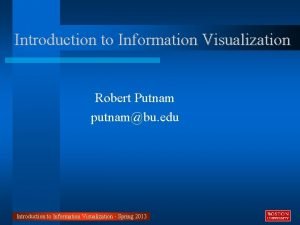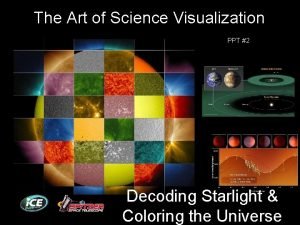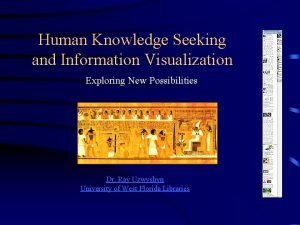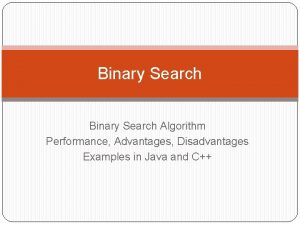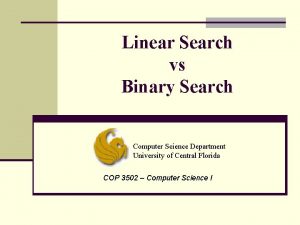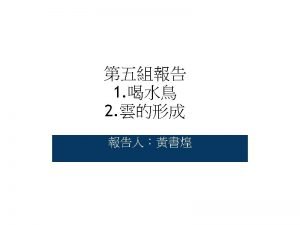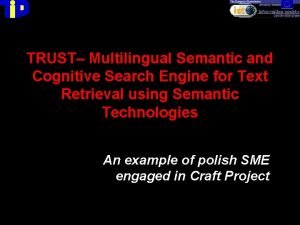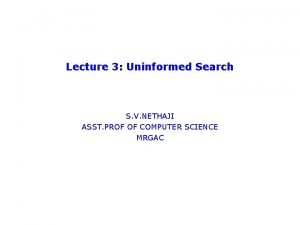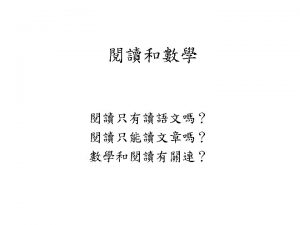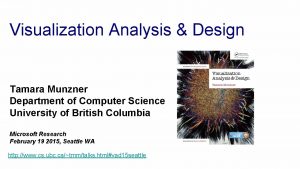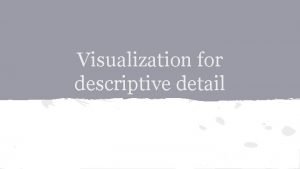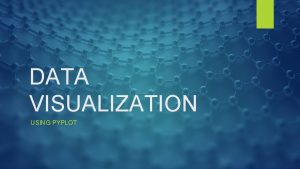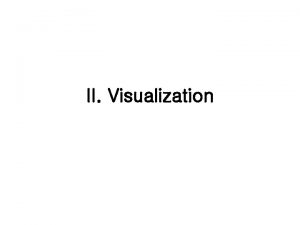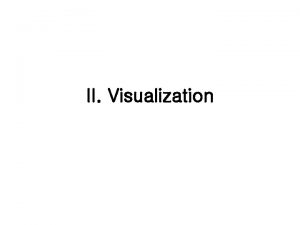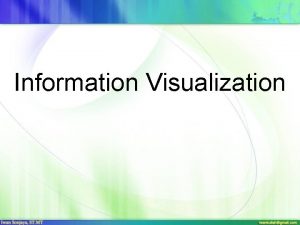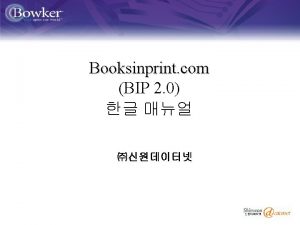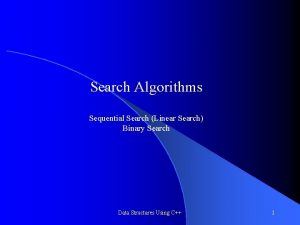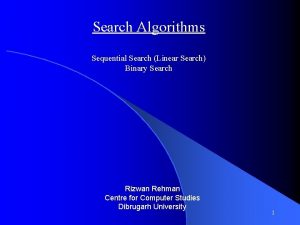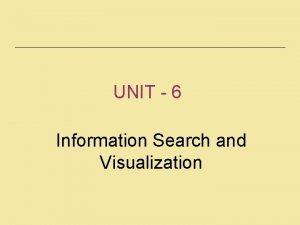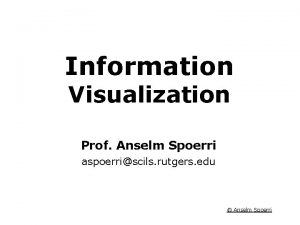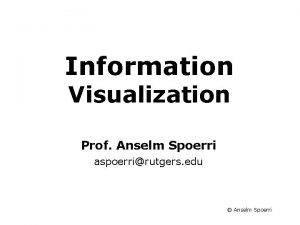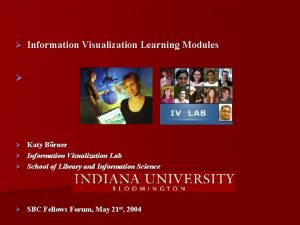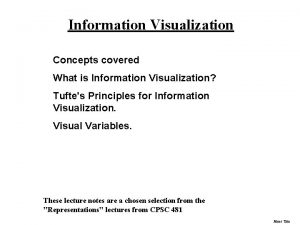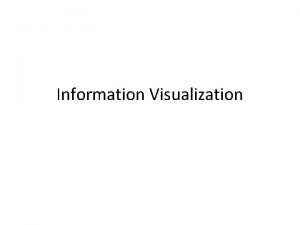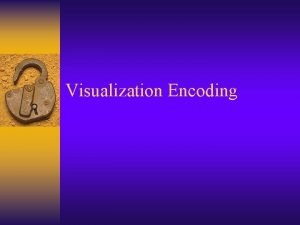14 Information Search and Visualization Introduction n information





















- Slides: 21

14. Information Search and Visualization

Introduction n information retrieval, database management information gathering, seeking, filtering, or visualization n data mining from data warehouses and data marts knowledge networks or semantic webs n information search using traditional UI – hurdle for novice users and an inadequate for experts n Improvements on traditional text and multimedia searching seem possible as a new generation of visualization strategies for query formulation and information presentation emerges n task actions (browsing or searching) represented by interface actions (scrolling, zooming, joining, or linking) n Tasks – specific/extended fact finding, exploration of availability, openended browsing and problem analysis

Searching in Textual Documents and Database Querying q search engine q SQL – requires training, and even then users make frequent errors q natural-language queries – appealing but limited computer processing capacity q form-fillin queries and query-by-example q simple and advanced search interfaces (fig. 14. 1) q five-phase framework 1. Formulation: expressing the search source, fields, phrases, variants 2. Initiation of action: launching the search explicit, implicit initiation, dynamic query 3. Review of results: reading messages and outcomes sequence and cluster 4. Refinement: formulating the next step history buffer 5. Use: compiling or disseminating insight

Multimedia Document Searches q Image search -- query by image content (QBIC) search for distinctive features or search for distinctive colors q Map search – search by features q Design or diagram search – finding engine designs with pistons smaller than 6 cm q Sound search – Music-information retrieval system q Video search q Animation search

Advanced Filtering and Search Interfaces 1. filtering with complex Boolean queries - difficulty of use 2. automatic filtering - user constructed set of keywords to dynamically generated information 3. dynamic queries - direct manipulation queries 4. faceted metadata search - integrating category browsing with keyword searching 5. collaborative filtering - each user rates items, and then system suggest unread items 6. multilingual searches 7. visual searches -

Information Visualization q How to present and manipulate large amounts of information in compact and user-controlled ways q Information visualization - the use of interactive visual representations of abstract data to amplify cognition q Resistance to visual approach - textual tools use compact presentations that are rich with meaningful information and comfortingly familiar q visual-information-seeking mantra – overview first, zoom and filter, then details on demand q Data type by task taxonomy (TTT) and seven tasks (Box 14. 2)

Information Visualization 1. 1 -D 1 inear data q in a sequential manner – textual documents, dictionaries, alphabetical list of names q interface-design issues include what fonts, color, size to use, and what overview, scrolling, or selection methods to provide for users 2. 2 -D map data q maps, floor plans, newspaper layouts q interface-domain features (size, color, opacity) q user tasks – to find adjacent items, regions containing items, paths between items and to perform the seven basic tasks

Information Visualization 3. 3 -D world data q Computer-assisted medical imaging, architectural drawing, mechanical design, chemical structure modeling, and scientific simulations q users’ tasks typically deal with continuous variables such as temperature or density q cope with the position and orientation when viewing the objects � potential problems of occlusion and navigation �overviews, landmarks, teleoperation, multiple views and TUI 4. Multidimensional data q n attributes in a n-dimensional space q tasks include finding patterns such as, clusters, correlations, gaps and outliers q three-dimensional scattergram (disorientation and occlusion)

Information Visualization 5. Temporal data q items have a start and finish time, and that items may overlap q finding all events before, after, or during time period and the seven basic tasks 6. Tree data 1. Treemap 7. Network data q shortest or least costly paths connecting two items or traversing the entire network

Information Visualization 8. Overview task q zoom-out views of each data type to see the entire collection plus detail view q movable field-of-view box (zoom factors of 3 to 30), fisheye strategy 9. Zoom task 1. to control zoom focus and zoom factor 10. Filter task 1. sliders, buttons, or other control widgets coupled with rapid display update

Information Visualization 11. Details-on-demand task q simply click on an item to get a pop-up window with values of each of the attributes 12. Relate task q proximity, containment, connection, color coding; highlighting 13. History task q history of actions to support undo, replay, and progressive refinement 14. Extract task 1. extract , save, send by electronic mail, insert, publish

Information Visualization 14. Challenges for information visualization 1. import data 2. combine visual representations with textual labels 3. see related information 4. view large volumes of data 5. integrate data mining 6. collaborate with others 7. achieve universal usability









 Introduction to information visualization
Introduction to information visualization Translate
Translate Information visualization
Information visualization What is informed search and uninformed search
What is informed search and uninformed search Uninformed search examples
Uninformed search examples Unified search vs federated search
Unified search vs federated search èinterest
èinterest Federated search vs distributed search
Federated search vs distributed search Images.search.yahoo.com
Images.search.yahoo.com Best first search is a type of informed search which uses
Best first search is a type of informed search which uses Heuristik
Heuristik Yahoo gravity
Yahoo gravity Yahoo search video
Yahoo search video Disadvantage of binary tree
Disadvantage of binary tree Linear search vs binary search
Linear search vs binary search Images search yahoo
Images search yahoo Semantic search vs cognitive search
Semantic search vs cognitive search Comparison of uninformed search strategies
Comparison of uninformed search strategies Yahoo
Yahoo Before and after data visualization
Before and after data visualization Tamara munzner
Tamara munzner Signal analysis and visualization
Signal analysis and visualization
